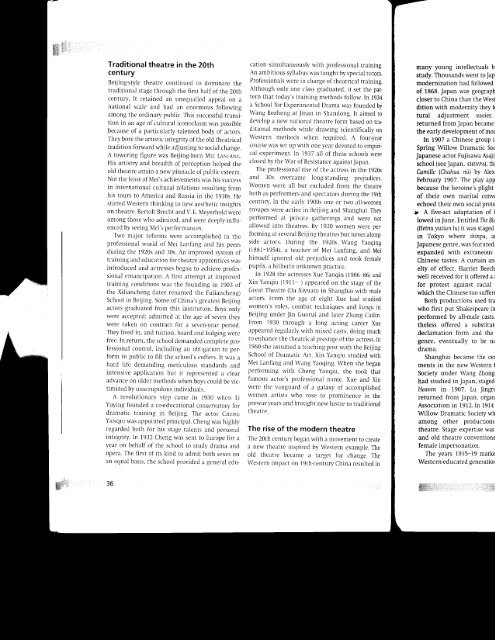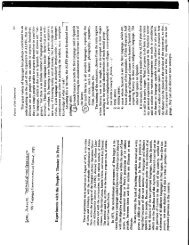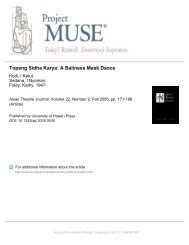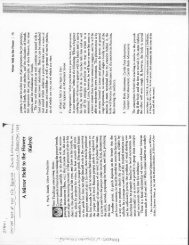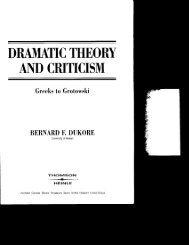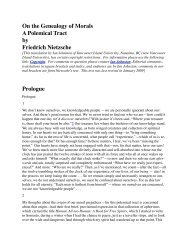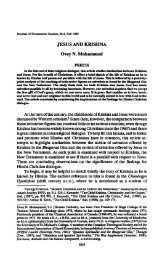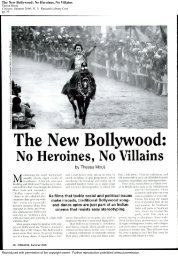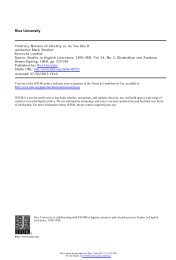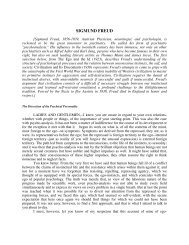Contemporary China - Yavanika
Contemporary China - Yavanika
Contemporary China - Yavanika
Create successful ePaper yourself
Turn your PDF publications into a flip-book with our unique Google optimized e-Paper software.
Traditional theatre in the 20th<br />
century<br />
Beijing-stylc theatre colttinuccl to doninatc the<br />
traditional stagc thlough the first halfof the 20th<br />
centr-lry. It retained au unequallcd appeal on a<br />
national scale and had an enormous following<br />
among the ordinary public. This successful transition<br />
in an agc of cultural iconoclasm was possible<br />
because of a particularly talented body of actors.<br />
They bore the artistic integrity ofthc old theatr.ical<br />
tradition forward while adjusting to social change.<br />
A towering figure was Beijing-born Mlr L,wr,eivc.<br />
His artistry and bleadth of perception helped the<br />
old theatrc attain a new pinnacle of public csteenr.<br />
Not thc lcast of Mei's achieventents was his success<br />
in international cultural rclations resrilting frolr]<br />
his touls to Anterica and Russia in the 1930s. Hr.<br />
stirred Western thinking to new aesthetic insights<br />
on theatre. Bertolt Brecht and V. E. Meyer.hold were<br />
anong those who admired, and were dceply influenced<br />
by secing Mei's pelfbrmances.<br />
Two major rcfblms were accontplishcd in thc<br />
professional world of'Mei Lanfang ancl his peers<br />
during the 1920s and 30s. An impr-oved system of'<br />
training and education fbr theatrc appr.enticcs was<br />
introduced and actresses bcgaD to achieve professional<br />
cnancipation. A first attcnpt at inpr.ovcd<br />
training conditions was thc founding in 1903 of<br />
the Xiliancheng (later rcnauted the Fuliancheng)<br />
School in tseijing. Some'of<strong>China</strong>'s greatest Btijing<br />
actors gracluated flom this instrtution. Boys only<br />
werc. acceptcd; admittcd at the age of seven they<br />
were taken on contract for a seven-ycar period.<br />
They lived in. and tuition, board and lodging werc<br />
free. In return, thc school dclnandcd conplcte profcssional<br />
control, including an obligation to perform<br />
in public to fill the school's coflers. It was a<br />
hard lifc demandinq neticr.rlous standards and<br />
intensive application but it represcnted a clear<br />
advance on older nethods when boys could be victimized<br />
by unscrupnlous individuals.<br />
A revolutionary stcp catne in 1930 whcn Li<br />
Yuying fbr-rnded a co-educational conservatory fbr<br />
drarnatic training in Beijing. l'he actor CHTiNG<br />
YlNqru was appointed principal. Cheng was highly<br />
regardecl both fol his stage talents and personal<br />
intesrity. In 1932 Cheng was sent to Europe for a<br />
year on behalf of thc school to study drama and<br />
opera. fhe first of its kind to adnit both sexes on<br />
an equal basis. the school providcd a gcneral edu-<br />
cation siruultaneously with professional training.<br />
An arnbitious syllabus was taught by special tutors.<br />
Profbssionals were in charge ofthcatrical training.<br />
Although only one class graduated, it set the pat<br />
teili that today's training metl]ods fbllow. In 1934<br />
a School fbr lxperimcntal Drana was founded by<br />
Wang Bozheng at Jinan in Shandong. It ainied to<br />
devclop a new national theatre fomr based on traditional<br />
methods whilc dlawing scientifically on<br />
Westeln methods whcn requirecl. A fbur-year<br />
coLrrse was sct up wlth one ycar devotcd to empirical<br />
expcrimeDt. In 1937 all of these scl]ools were<br />
closed by the War ofResistancc against<br />
Japan.<br />
Thc. professional lisc of the actress in the 1920s<br />
and 30s ovcl'cane long{tanding pr.ejudices.<br />
Women were all but exclr-rded fiom the theatre<br />
both as performers and spectators during the 19th<br />
centr.rry.<br />
In the eally 1900s one or two all-wonren<br />
troupes were activc ir) Beijing and Shanghai. They<br />
perfblmed at privatc gatherings ancl were not<br />
allowed into thcatles. By 1920 women wcre per.<br />
folming at sevcral Beijing theatres but never alongside<br />
acto|s. Durir-rg thc 1920s Wang yaoqing<br />
(1881-1954), a teacher of Mci Lanfang, and Mei<br />
himself ignored old prejr.rdices and took female<br />
pttpiJs. a hilheflo rrnLlown l)lr( ricc.<br />
ln 1928 the actressL.s Xue Yanclin (190686) and<br />
Xrn Yanqiu (1911- ) appcarecl on the stagc of the<br />
Cleat Thc.atrc (Da Xiyuan) in Shanghai with male<br />
actors. Froln the age of e.ight Xue had studied<br />
womcn's roles, combat techniques and kunql in<br />
tseijing under Jin Gr.rorui and latcr Zhang Cailin.<br />
From 1930 thror.rgh a long acting career Xue<br />
appearcd regr.rlarly with mixed casts, doing rnuch<br />
to erhancc the theatrical prcstigr. of the actress. In<br />
1960 she assume'd<br />
a tcaching posr with the Bcijing<br />
School of Drarlatic Alt. Xin Yanqiu studied with<br />
Mei Lanfang and Wang Yaoqing. When she began<br />
perfbnning with Cheng Yancliu, she took that<br />
famous actor's plof'cssional narne. Xue and Xin<br />
were thc vanguard of a galaxy of accomplished<br />
won-teu artists who rose to prominence in the<br />
prewaryears and brought new lustre to traditional<br />
tneatre.<br />
The rise of the modern theatre<br />
The 20th century bellan with a movenent to create<br />
a ncw theatrc inspired by Westent exaruple. The<br />
old thcatre bccame a target fbr change. The<br />
Western impact on 1gth-ceutury <strong>China</strong> rcsulted in<br />
many young intellectuals b<br />
study. Thousands went to Jap<br />
modernization had followed<br />
of 1868. Japan was geograp<br />
closer to <strong>China</strong> than the Wes<br />
dition with modernity they fi<br />
tural adjustment easier<br />
returned from Japan became<br />
the early development of mor<br />
In 1907 a Chinese group i<br />
Spring Wiliow Dramatic So<br />
Japanese actor Fujisawa fuaji<br />
school (see Japan. SHTNPA) th<br />
Camille (Chahua nri) by Alex<br />
February 1907. The play app<br />
because the heroine s plight<br />
of their own marital convt<br />
echoed their own social prote<br />
+ A five-act adaptation of I<br />
lowed in June. Entitled The Blt<br />
(Heinu yutian lil) it was staged<br />
in Tokyo where shinpa, a<br />
Japanese genre, was featured<br />
expanded with extraneous<br />
Chinese tastes. A curtain an<br />
elry of effect. Harriet Beec<br />
well received for it offered a r<br />
for protest against racial<br />
which the Chinese too sufferr<br />
Both productions used tra<br />
who first put Shakespeare in<br />
performed by all-male casts<br />
theless offered a substitut<br />
declamation form and the<br />
genre, eventually to be n;<br />
drama.<br />
Shanghai became the ce<br />
ments in the new Western I<br />
Society under Wang Zhong<br />
had studied in Japan, staged<br />
Heaven in 1907. Lu Jingn<br />
returned fiom Japan, organ<br />
Association in 1912. In 1914<br />
Willow Dramatic Society wh<br />
among other productions<br />
theatre. Stage expertise was<br />
and old theatre convention<br />
female impersonation.<br />
'Ihe years 1915-19 mark€<br />
Westerneducated generatio<br />
50<br />
#*'


